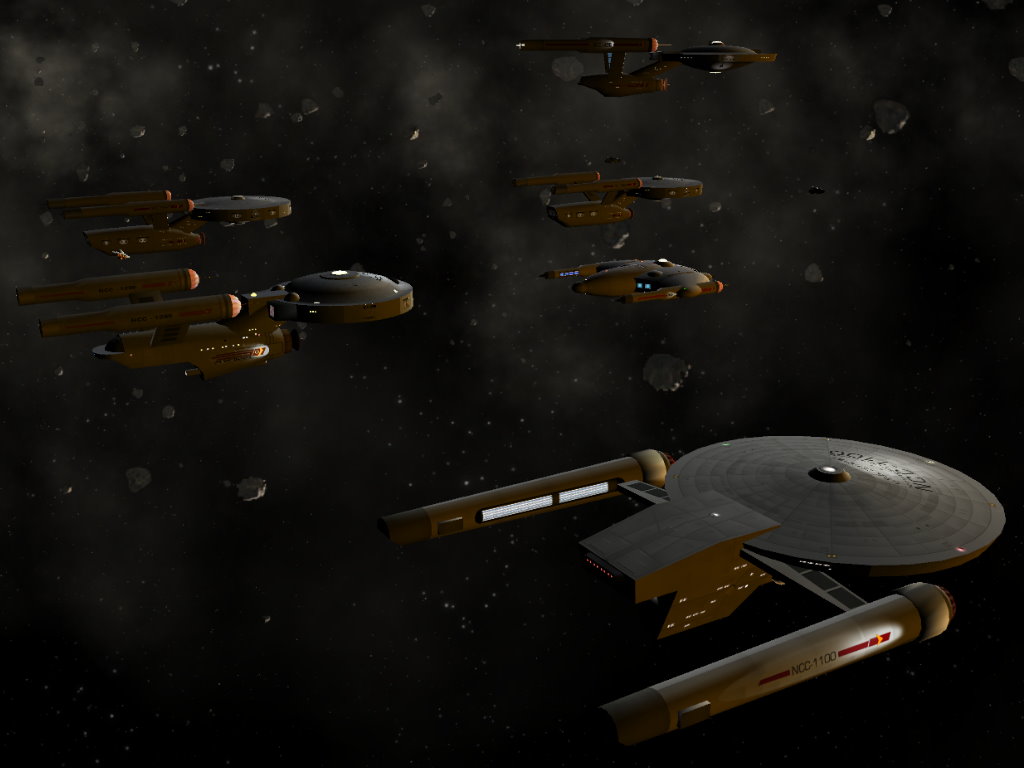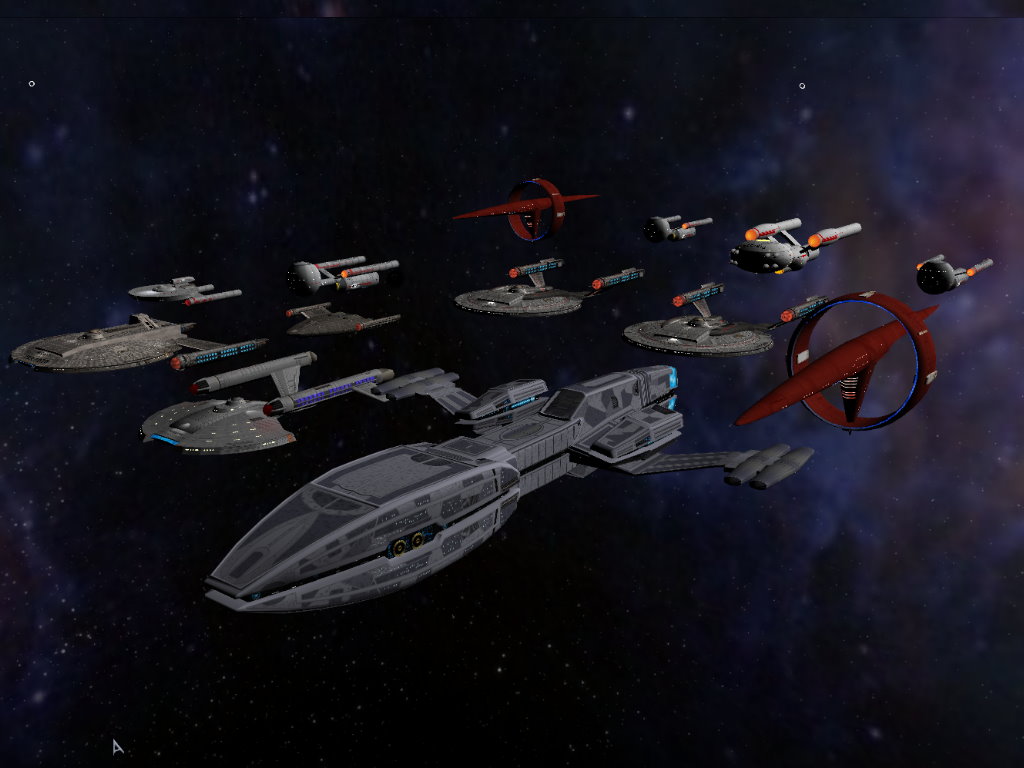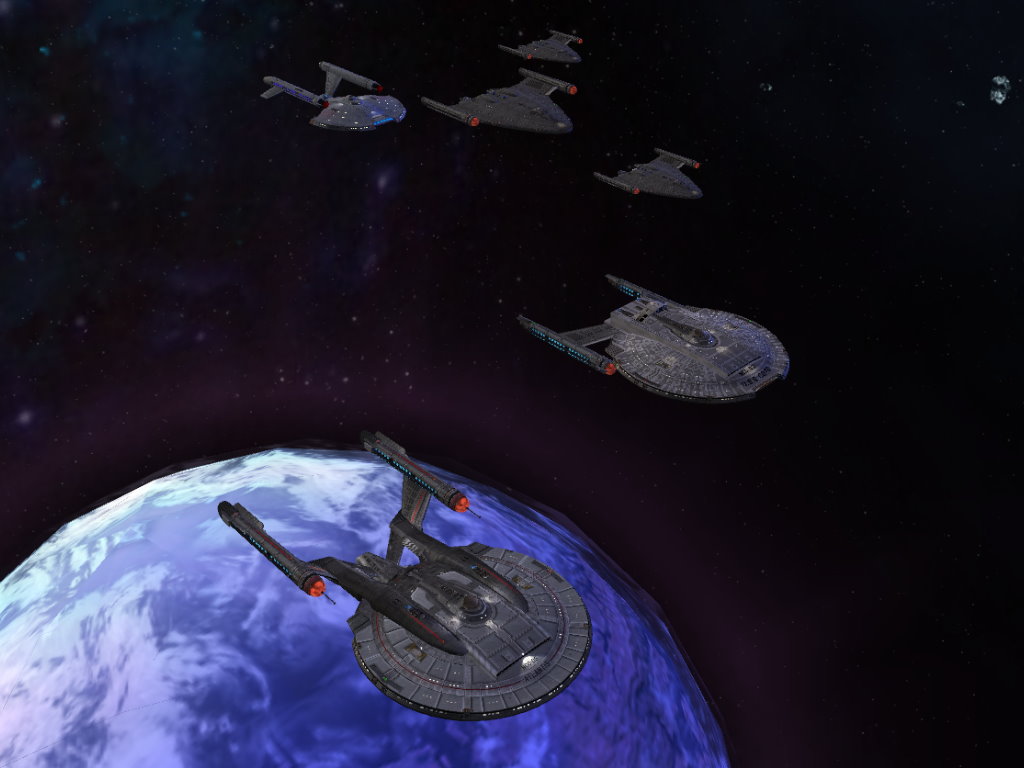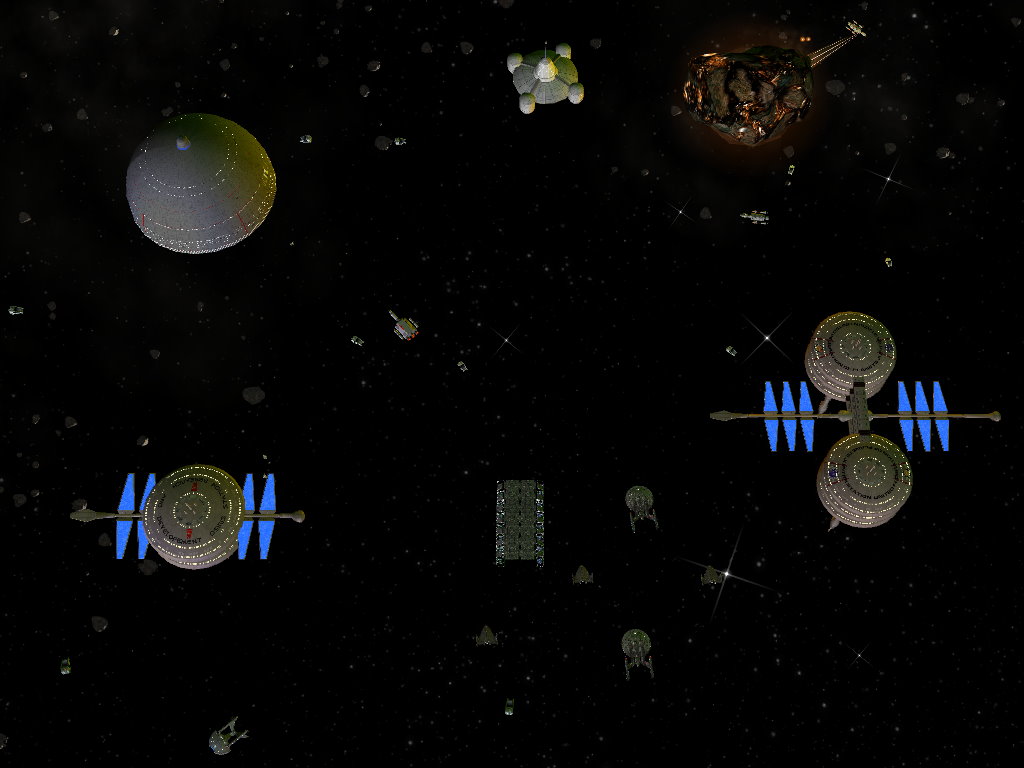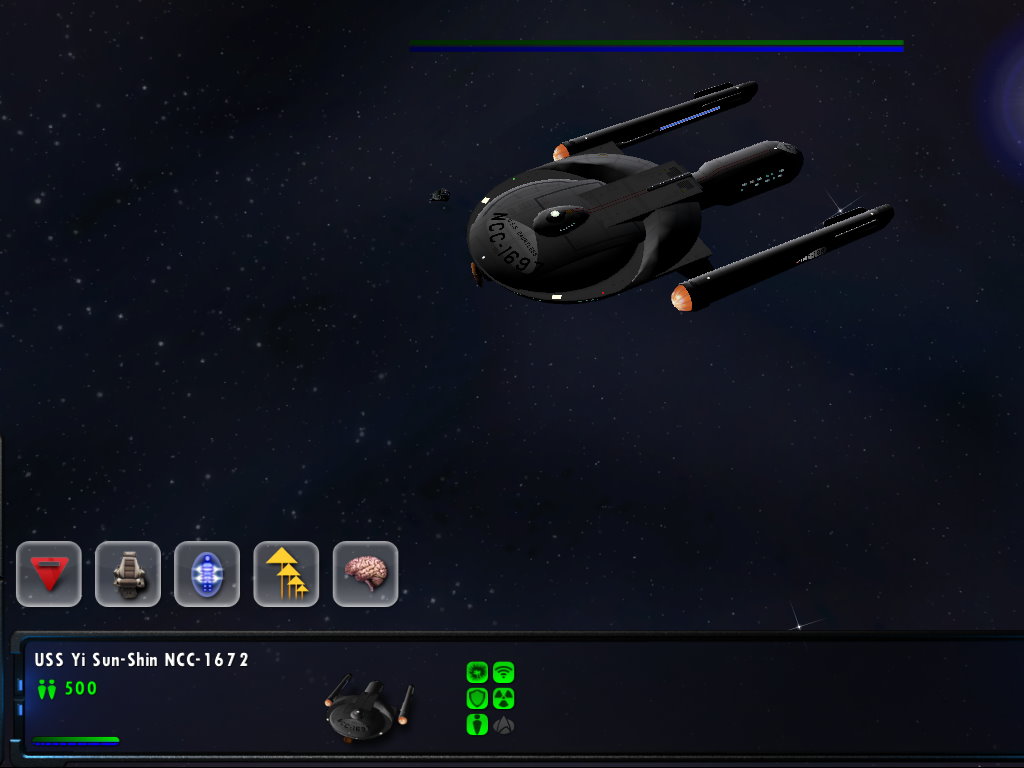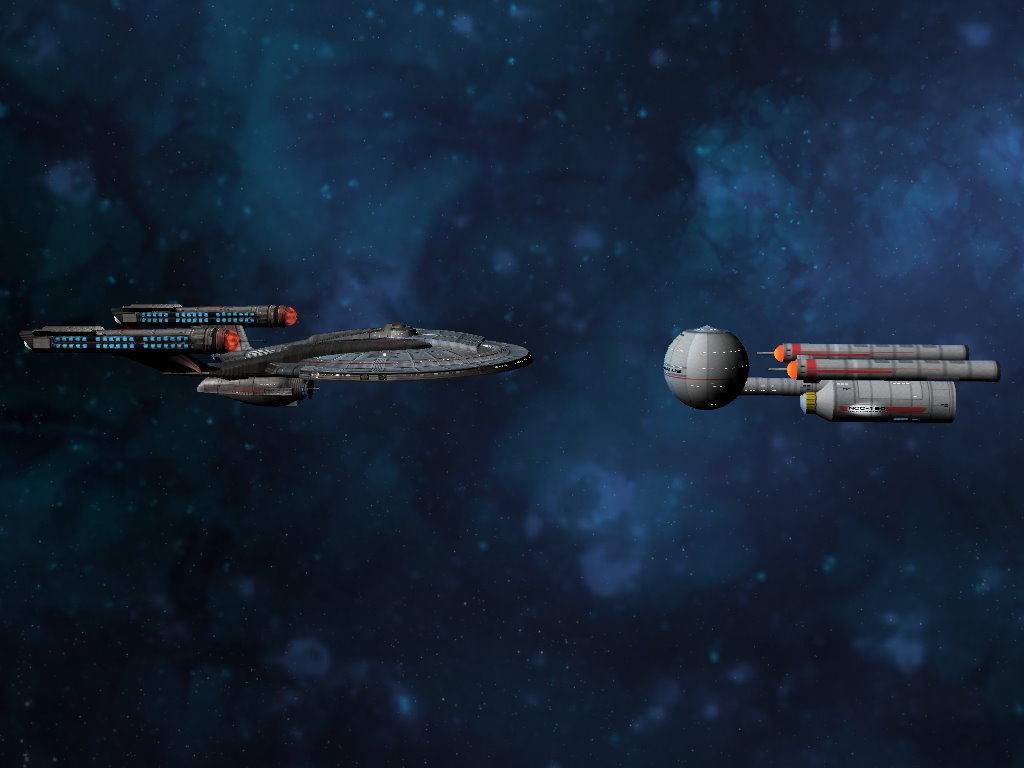When I started working on this mod, I never thought that working on the Federation would be the most difficult task. Not because of the lack of ideas of course, on the contrary! In Star Trek, the Feds are the good guys. You see everything form their perspective (and the reason DS9 was so great is that it sometimes changes that), they are the ones with whom you can identify yourself, you can understand them, you cheer for them. They always have the most advanced starship, the fanciest gizmos, the most detailed technological background for everything from tricorders to turbolifts, to warp theory and to fleet command structure. There are so many awesome designs out there - canon and fan made - and in a mod such as this you want to have as many of them as possible. I could spend the rest of my life building a mod only about the Federation! But you have to balance all the magnificent stuff the Federation has to the other factions, and you have to make the other factions feel complete and enjoyable as well, which takes time away from tinkering with the Federation.
So I had to give up some of my ideas for the Federation, at least until I can figure out something equally good for the Klingons and the Romulans too. That's why there will be only a handful of special weapons in the mod upon release and that's why there are some Federation ships that could be represented here but are still absent. These may come later, when the mod is up and running.
Now, let's take a look at the last faction of Evolution, the one that everyone will surely try first and will play the most.
Historical and political background:
The history of the United Federation is Planets is the briefest of the three main factions. It starts in 2063 when the first warp-capable vessel is launched from Terra - or if you prefer, Earth - and when the Terrans make first contact with the Vulcans, and prepare to become a member of the interstellar community. In the next century the fragmented nations of Earth unite and soon the first starship capable of Warp 5 is launched. A significant step, indicating that Humans fully mastered space travel. This event shakes up the status quo of the region. The Terrans are not only a fast-breeding and therefor thrill seeking and adventurous species, but they are capable diplomats and engineers as well. The Cochranian warp theory turns out to be much more efficient than anything else used by the other species so Terran ships quickly become the fastest in the quadrant. Thanks to their diplomatic skills, Terran ambassadors defuse the Vulcan-Andorian conflict which opens the possibility of a broader interstellar cooperation. Feeling threatened by the potential of such alliance, the Romulan Star Empire launches a preemptive attack on the Terran colonies but it is soon defeated by the Coalition of Terra, Vulcan, Andoria, Denobula and Tellar, and one year after the war ends, in 2161, the United Federation of Planets is born.
The newborn Federation begins a quick expansion, integrating other planet states and establishing new colonies - especially by Terrans - on an increasing pace. This quick colonization brings unprecedented prosperity and technological development to its members. As Terrans are the main catalysts of the events, they profit most from the benefits as well, which soon leads to the first of many internal conflicts among the member species members. Meanwhile the expansion provokes the neighboring empires, especially the Tholians, the Gorn and the Klingons, and border conflicts gradually become common alongside the Federation borders.
Even though total war is avoided on several occasions, relations with the Klingons become icy to the point where the parties are openly hostile toward each other. The relations with the Tholians aren't much better either. Among these circumstances the Federation is a bit too eager to rush to help out the Kzinthi against the Klingons and the Lyrans in the last Four Years War. Not suffering from a lasting war before and being a both economic and military powerhouse by then, public opinion in the Federation almost demands to join into the war against the Klingons. But the intervention is only a beginning of a series of events that turn a limited conflict into a full-scale interplanetary war that lasts for the next fifteen years and engulfs the whole Alpha Quadrant with flames...
How to play as the Federation?
At the beginning of the game, the Federation doesn't even exist. Instead, you begin as the United Earth. This means that you will suffer from limited infrastructure, you won't have access to a starbases or weapon platforms, building construction is slow, mining ships have small storage capacity, and you have to start your research with basic technologies like transporters and stabilized warp fields. One of the main focus of the Federation player should be to research these basic technologies fast to gain access to stronger starships. But once you achieved that, you will find that the Federation easily adapts to any tactical situation.
Meanwhile you may rely on the influence of your ambassadors and ask for the help of your allies.
Thanks to being the beacon of liberty, sciences thrive in the Federation, which means that research will be fast and moderately expensive, but unfocused. There are three research facilities, the Starfleet Research Facility (the bottom left one on the picture bellow) focuses mostly on starship subsystems, the Federation R&D Institute (the station on the right) focuses mainly on "special" researches, and the Starship Design Bureau (top left) is responsible for designing new ships.
Federation starship research differs from the Romulan or the Klingon approach. While those factions research technologies to build stronger starships, the Federation designs starships around available technologies. Therefor you'll almost certainly have a new starship available, regardless of your technology level, so you can react faster to any change in the balance of power by building a few from your newest ships, while other factions may be stuck with older designs while they await for their stronger ships become available.
The Federation technology tree is not linear, it's more like a mesh of researches where every new technology may open up new options, but every new technology may require several other, before it can be researched. This means that rushing for certain technologies or ships may prove difficult, in some cases evemn impossible. But you may gain access to some specialized ships that excel in one area or another. On the other hand, there are relatively few well-balanced ships in Starfleet that can effectively survive on their own, although for a long time, this was the designer's goal. Therefor, while the Klingon or Romulan player may build a powerful fleet of only one or two classes, the Federation is more effective if you combine several types into your fleet.
The Federation has dedicated carrier ships and some other ships that may accommodate fighters, but the squadrons will never be as strong as their Klingon counterpart. The player may also gain access to a reserve fleet once a Federation reserve is formed, and as time advances the mothball will more and more diverse and a great source to get some old ships that are no longer in production.
It is only a vanity thing, but every Federation starship has its own pool of registry numbers based on a database I created and that has some 13.000 entries based on various sources. As time advances you will notice that the registry numbers increase as well, meaning that while you'll be able to build Excelsiors with 2xxx registry number, later every Excelsior you build will have higher numbers. This mechanism is only there to add some immersion to the game, it doesn't come with any extra benefit, but it feels nice to see when a very old ship that you built at the beginning of the game is still alive and you can browse its achievement in the Admiral's Log. Note though that the different registry numbers won't appear on the models. It could be done, but it would be an enormous task and it would take so many extra texture files that gameplay would be significantly slower, something I want to avoid.
Strengths & Weaknesses
+ Several starship designs
+ Fast research
+ Several special technologies
- Very low starting tech level
- Must mix ships
- Few well-rounded ships
The Daedalus Controversy:
This controversy was created by the franchise itself, namely how can the ship on the left be more advanced in technology than the one on the right:
In one hand, there is the completely canon Daedalus Class that can be seen on several occasions in Sisko's office on Deep Space 9. Clearly an ancient design with spherical main hull and tubular secondary hull. On the other hand there is the NX class, the main ship of Star Trek: Enterprise. It is mockingly called the "Akiraprise" because its design is basically an upside-down Akira Class from First Contact. As we know United Earth used the NX and the Federation used the Daedalus , the NX is clearly the older design. I found the solution to this controversy partly in the Enterprise series and partly in Starfleet Museum.
According to Evolution, while the NX class was an impressive piece of technology and a comfortable starship to live in, it was an ineffective design. A few good hits could cause a catastrophic structural failure that couldn't be contained even by force fields. This became painfully obvious during the first days of the Romulan War, when no less than three NX Class starships were destroyed. Therefor the designers went back to the basics. Spherical and tubular shapes have the most structural stability, and new technologies like shield bubbles and structural force field generators could support spherical or tubular bodies easier, meaning that the energy requirement of creating a proper structural integrity field on the Daedauls costs a fragment of what it would take on the NX.
Ugly? Yes. Uncomfortable? You bet! Isn't effective shape for warp speed? Of course! But it was super effective, cheap construction, easy to maintain and had better survival chances than the NX Class had. And that was all that mattered during the Romulan War.
Later as technology developed, systems became more efficient, Starfleet gradually returned disk-shaped and more streamlined hulls that have a much smaller frontal profile, and because of the laws o warp mechanics, drastically reducing the energy requirement of high warp travel. This was a crucial point because even with he best recent technologies, it would take a warp core of an Excalibur Class starship to boost a Daedalus to Warp 9. Bu that warp core would never fit into the hull of the Daedauls...
That's all for now. I wonder what the next article will be about... ;)
